Accessibility Barriers in K–12 Digital Learning Platforms for Students with ADHD: Addressing Executive Function and Cognitive Load Challenges
Belen Echegaray
Introduction
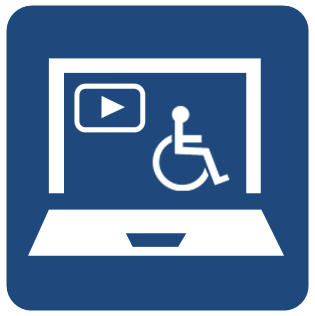 As digital learning platforms become integral to Kindergarten through Grade 12 education, the need for inclusive and accessible design has grown more urgent. Accessibility in education involves eliminating barriers that prevent learners with disabilities from fully participating and achieving their goals. While accessibility is often framed in terms of physical or sensory accommodations, students with cognitive and attentional disabilities, like Attention Deficit Hyperactivity Disorder (ADHD), face less visible but significantly impactful challenges. These challenges are most evident in digital environments that assume consistent attention, executive functioning, and independent time management, all of which are areas in which many students with ADHD experience difficulty (Hart Barnett, 2017).
As digital learning platforms become integral to Kindergarten through Grade 12 education, the need for inclusive and accessible design has grown more urgent. Accessibility in education involves eliminating barriers that prevent learners with disabilities from fully participating and achieving their goals. While accessibility is often framed in terms of physical or sensory accommodations, students with cognitive and attentional disabilities, like Attention Deficit Hyperactivity Disorder (ADHD), face less visible but significantly impactful challenges. These challenges are most evident in digital environments that assume consistent attention, executive functioning, and independent time management, all of which are areas in which many students with ADHD experience difficulty (Hart Barnett, 2017).
ADHD is characterized by persistent patterns of inattention, impulsivity, and functional limitations or impairments (Government of Canada, Public Service Commission, 2016). When working memory is overtaxed, learning becomes inefficient (Sweller, 1994). Digital platforms that require multitasking or frequent switching between tabs can exacerbate this issue for learners with ADHD. In digital learning contexts, these impairments are often intensified by the structure and presentation of educational technologies. Platforms that lack organizational clarity, provide inconsistent visual cues, and frequently fail to scaffold tasks which increase cognitive load and reduce engagement for students with ADHD (Sweller, 1994). Without intentional design for cognitive load, these tools may unintentionally exclude neurodivergent learners from succeeding in online learning environments.
However, it is important to note that not all students with ADHD experience barriers in the same way. Factors such as race, class, gender, and language background intersect with disability in ways that affect access to diagnosis, support, and academic success (Miller et al., 2023). For example, racialized students are often underdiagnosed or misdiagnosed and may encounter additional bias when navigating digital platforms designed with a normative learner in mind. Recognizing these intersections underscores the need for more flexible and inclusive design practices that accommodate a broader range of learner identities.
This paper argues that digital learning platforms used in Kindergarten through Grade 12 education often create accessibility barriers for students with ADHD by failing to accommodate executive function and cognitive load needs, and that these barriers can be reduced through intentional instructional design and digital strategies grounded in Universal Design for Learning principles.
ADHD, Executive Function, and the Accessibility Gap
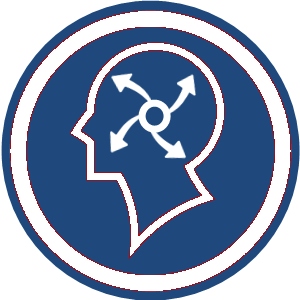 Attention Deficit Hyperactivity Disorder (ADHD) is a neurodevelopmental condition that significantly impacts learning, particularly in digital contexts where students are expected to self-regulate, sustain attention, and navigate complex platforms independently. ADHD is identified by symptoms such as distractibility, disorganization, impulsivity, and restlessness, with wide variation in how these characteristics present across students (Centers for Disease Control and Prevention, 2022). These symptoms are closely linked to executive functioning difficulties, which include challenges with working memory, flexible thinking, emotional regulation, and goal-directed behaviour (Barkley, 2010). Although these cognitive characteristics are central to a diagnosis of ADHD, they are often underrepresented within conversations about digital learning accessibility.
Attention Deficit Hyperactivity Disorder (ADHD) is a neurodevelopmental condition that significantly impacts learning, particularly in digital contexts where students are expected to self-regulate, sustain attention, and navigate complex platforms independently. ADHD is identified by symptoms such as distractibility, disorganization, impulsivity, and restlessness, with wide variation in how these characteristics present across students (Centers for Disease Control and Prevention, 2022). These symptoms are closely linked to executive functioning difficulties, which include challenges with working memory, flexible thinking, emotional regulation, and goal-directed behaviour (Barkley, 2010). Although these cognitive characteristics are central to a diagnosis of ADHD, they are often underrepresented within conversations about digital learning accessibility.
In digital learning environments, executive function is not viewed as a skill set but instead as a requirement to use most platforms. Students are frequently expected to track assignments across multiple tabs, interpret layered instructions, respond to feedback, and meet deadlines without direct supervision. These expectations assume a learner is capable of managing multiple streams of input, prioritizing tasks, and sustaining focus. These capabilities may not be reliably present for students with ADHD. Learners with ADHD often experience difficulty with self-regulation, especially when presented with disorganized or high-load cognitive tasks, particularly in screen-based settings (Barkley, 2010). When digital learning tools are not designed with these cognitive realities in mind, they create not just usability challenges, but systemic access barriers.
Cognitive Load Theory further illuminates the difficulty. Sweller (1994) explains that when students are required to devote their cognitive resources to navigating an interface or locating information, their ability to engage with academic content greatly diminishes. For students with ADHD, the cognitive cost of accessing materials often outweighs the learning gains those materials are meant to support. Platforms that present long lists of tasks without visual chunking or cues impose a high cognitive load. This undermines both learning efficiency and task completion, disproportionately affecting students with ADHD who rely on external structures to support focus and memory.
From an accessibility standpoint, the lack of accountability for cognitive and executive function differences reflects a gap in digital design practice. Many digital tools are built around assumptions of linear attention, singular focus, and self-pacing (Orey, 2010). These design defaults benefit learners who conform to neurotypical patterns of engagement but penalize those who do not. Without intentional design strategies that reduce cognitive load and scaffold executive function, digital platforms risk excluding students who may already be marginalized within the education system.
Students with ADHD were more likely to miss assignment instructions, skip embedded content, and require additional teacher intervention when the interface lacked visual structure and indicators. This underscores the importance of aligning digital learning environments with the cognitive accessibility needs of diverse learners (Hart Barnett, 2017).
True accessibility in education goes beyond technical requirements and must also consider how cognitive justice shapes student experiences. If digital learning platforms continue to overlook the characteristics of ADHD and the barriers they present, students with these profiles will remain structurally disadvantaged, even within systems that claim to be inclusive.
Analysis of Platform Barriers
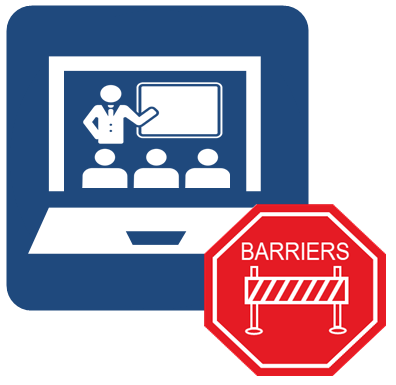 Digital learning platforms are now central to many classrooms across Kindergarten through Grade 12, yet their design often reflects assumptions about how students process, prioritize, and manage information. For students with ADHD, whose executive functioning may be impaired, these assumptions create difficulty that can severely reduce their access to learning. It is imperative to critically examine how widely used platforms such as Google Classroom (Google, n.d.) and Canvas (Instructure, n.d.) can pose accessibility challenges by overloading working memory, under-supporting self-regulation, and failing to account for attentional diversity.
Digital learning platforms are now central to many classrooms across Kindergarten through Grade 12, yet their design often reflects assumptions about how students process, prioritize, and manage information. For students with ADHD, whose executive functioning may be impaired, these assumptions create difficulty that can severely reduce their access to learning. It is imperative to critically examine how widely used platforms such as Google Classroom (Google, n.d.) and Canvas (Instructure, n.d.) can pose accessibility challenges by overloading working memory, under-supporting self-regulation, and failing to account for attentional diversity.
One of the most common issues is the unstructured layout found in platforms like Google Classroom. Its main dashboard often presents classwork and announcements in a reverse chronological stream, without a fixed organization of files, tasks, or updates. For students with ADHD, this layout can become a source of constant confusion, especially when tasks are not grouped by topic or date (Hart Barnett, 2017). Similarly, Canvas allows for diverse organizational structures per educator, meaning each class a student is enrolled in may be structured distinctly. This inconsistency can lead to student confusion, having them use additional cognitive resources on scanning and re-scanning the platform to acclimate themselves to each unique arrangement. This often results in a reluctance to fully access or engage with the platform. Rather than facilitating access, this interface causes extraneous cognitive load, forcing students to interpret the interface rather than engage directly with the content. This disconnect aligns with findings from cognitive load theory, which stresses the importance of minimizing non-essential mental effort in instructional environments (Sweller, 1994).
Seesaw (n.d.), a platform often used in primary grades, relies heavily on visual media, voice recordings, and class journals. While these features can support multimodal learning, they often lack built-in executive function scaffolds such as checklists, timelines, or automated reminders. Tasks are commonly nested within image-based icons or creative posts, requiring students to infer instructions independently. For learners with ADHD, especially younger students who are still developing self-management skills, these omissions can lead to misinterpretation, missed steps, or task abandonment (Hart Barnett, 2017).
In secondary contexts, platforms like Brightspace (D2L, n.d.) or Edsby (CoreFour, n.d.) may offer more structure, yet still pose barriers by relying on complex navigation paths. Similarly to Canvas, these platforms do not provide consistent formatting across courses; A student might encounter one teacher who embeds all content within weekly modules and another who posts files across multiple tabs. This variation increases the mental effort required to locate and interpret materials. This creates a form of hidden curriculum that rewards students who can self-organize and penalizes those who cannot (Orey, 2010).
These challenges are not isolated usability issues. They point to a broader systemic problem in how digital learning environments are conceptualized and developed. Many platforms prioritize simplicity for instructors or offer too much design flexibility, often at the expense of neurodivergent learners. These students need predictable structures, minimal distractions, and explicit instructional pathways to allow for true success. Without deliberate design attention to executive function support, coupled with clear pedagogical guidelines or training for educators on consistent platform structuring, digital platforms risk reinforcing patterns of exclusion and disengagement that contradict the goals of accessible education.
Instructional Design and Digital Solutions
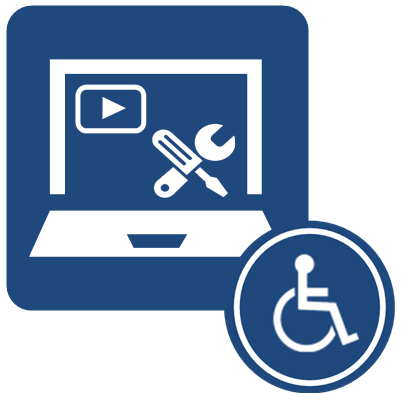 Effectively addressing the cognitive and executive function barriers that students with ADHD face in digital learning environments means deliberately integrating instructional design strategies and thoughtfully developing digital resources. Rather than relying on retroactive accommodations, the goal is to proactively design platforms and content that are already accessible and foster equitable engagement and learning for all students. This approach focuses on principles that aim to minimize extraneous cognitive load and provide support for self-regulation and maintaining focus.
Effectively addressing the cognitive and executive function barriers that students with ADHD face in digital learning environments means deliberately integrating instructional design strategies and thoughtfully developing digital resources. Rather than relying on retroactive accommodations, the goal is to proactively design platforms and content that are already accessible and foster equitable engagement and learning for all students. This approach focuses on principles that aim to minimize extraneous cognitive load and provide support for self-regulation and maintaining focus.
An imperative instructional strategy involves chunking and visually structuring content. Drawing on Cognitive Load Theory, which emphasizes minimizing non-essential mental effort (Sweller, 1994), educators should break down complex assignments, readings, and modules into smaller, digestible segments.
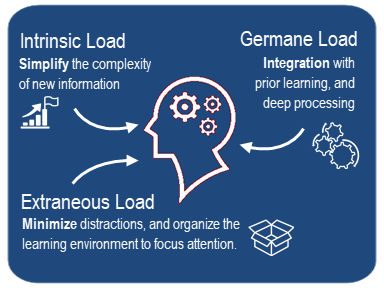
Digital platforms can facilitate this by allowing teachers to create highly organized modules with clear progression indicators, visible timelines, and sections for different task components. For instance, instead of long, scrolling pages of instructions, information can be presented in collapsible sections or through a series of short, linked pages. Visual aids like flowcharts, concept maps, and simplified navigation menus further reduce the cognitive load associated with interpreting the platform itself, allowing students to focus on the academic content (Hart Barnett, 2017). This structured approach directly supports learners with ADHD who benefit from external organization to compensate for internal executive function difficulties (Barkley, 2010).
Looking outside of content organization, digital solutions should integrate features that actively scaffold executive functions and promote self-regulation. Platforms can incorporate built-in visual timers for tasks, customizable reminder systems for deadlines, and digital checklists that allow students to track their progress. By embedding executive function supports into digital platforms, such as visual schedules and simplified dashboards, task initiation struggles can be significantly reduced (McKenna and Conradi Smith, 2023). These features move beyond simply presenting information to actively supporting how students with ADHD learn. Offering a ‘focus mode’ that minimizes visual clutter and disables non-essential notifications can create a less distracting screen-based environment, directly addressing the attentional challenges many neurodivergent learners face in digital spaces (Hart Barnett, 2017). Additionally, accessible digital platforms should facilitate the option for students to transition work offline, providing easily printable versions of assignments, readings, or organizers. This flexibility supports learners who benefit from physical interaction with materials for focus or to simply disengage from screentime distractions when needed, empowering self-regulation strategies (Orey, 2010).
The framework for these solutions is Universal Design for Learning (UDL) (CAST, 2025). UDL advocates for providing multiple means of representation, action and expression, and engagement (Orey, 2010).
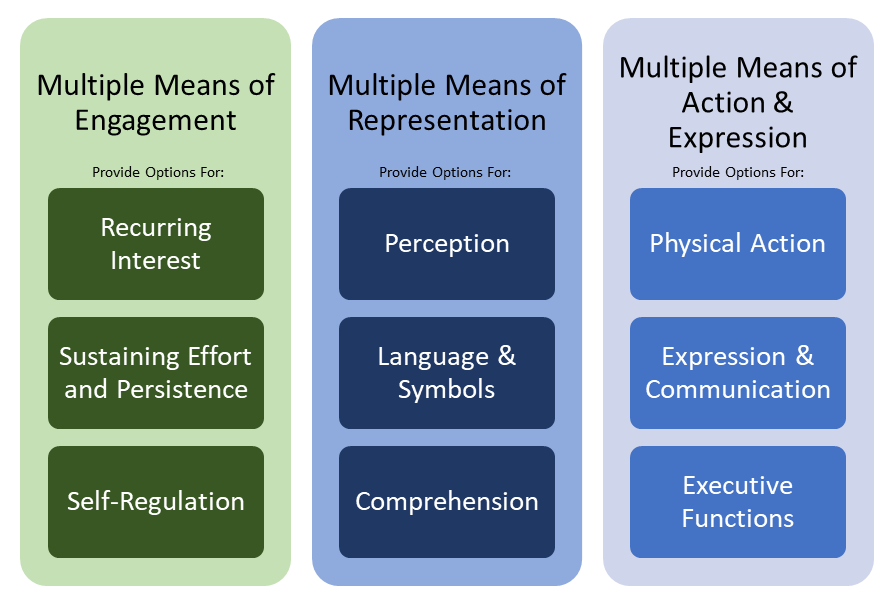
For students with ADHD, this translates to offering information in varied formats and providing flexible options for demonstrating understanding. Including help that students stay motivated and focused, like interactive tools, means designing for diverse cognitive profiles, including learners with ADHD, from the start. Accessibility becomes part of the initial plan, not something to be added later.
Implementing such instructional design strategies and integrating these digital features not only creates more accessible learning environments for students with ADHD but also yields more benefits for the entire student population. A clearer, less cluttered interface, structured content, and tools that support task management reduce cognitive overloads for all learners, enhance engagement, and promote independent learning skills.
While UDL offers a promising framework for inclusive education, it is not a universal solution. Many UDL implementations fail to address the needs of students with complex neurodevelopmental profiles, such as those with ADHD (Al-Azawei et al., 2016). Similarly, even well-intentioned digital accommodations, like focus modes or progress trackers, may be ineffective if not personalized. This highlights the need for multiple layers of support combining good design with classroom-based strategies and student voice.
Conclusion
The increasing integration of digital learning platforms into Kindergarten through Grade 12 education presents both opportunities and challenges, particularly concerning accessibility for neurodivergent learners, specifically those with Attention Deficit Hyperactivity Disorder (ADHD). Design assumptions focusing on linear attention and self-pacing, combined with inconsistent organizational structures within digital learning platforms, like Google Classroom and Canvas, fail to adequately accommodate students’ executive function and cognitive load needs. This can lead to increased cognitive strain and disengagement (Sweller, 1994).
In order to reduce these accessibility issues, intentional instructional design strategies and thoughtful digital resource development are essential. Proactive approaches, rather than reactive accommodations, can minimize cognitive load and promote self-regulation. Key solutions involve visually chunking content, integrating built-in executive function scaffolds like timers and checklists, offering focus modes, and providing flexible options for learners, such as the ability to transition work offline for sustained focus (Barkley, 2010). These strategies align directly with UDL principles, and look to multiple means of representation, engagement, and action and expression to help diverse cognitive profiles from the start.
Ultimately, ensuring true accessibility in digital learning extends beyond technical compliance; it demands a commitment to cognitive justice. By prioritizing design that supports the unique needs of students with ADHD, including clear pedagogical guidelines for educators on consistent platform structuring, digital platforms can avoid reinforcing patterns of exclusion. When UDL principles are applied with attention to cognitive diversity and intersectionality, they not only empower students with ADHD but also enhance learning for the entire student population by creating clearer and less overwhelming learning experiences. Investing in accessible digital design is therefore an investment in equitable education for all.
References
Al-Azawei, A., Serenelli, F., & Lundqvist, K. (2016). Universal Design for Learning (UDL): A Content Analysis of Peer Reviewed Journals from 2012 to 2015. Journal of the Scholarship of Teaching and Learning, 16(3), 39–56. https://doi.org/10.14434/josotl.v16i3.19295
Barkley, R. A. (2010). The Important Role of Executive Functioning and Self-Regulation in ADHD. Russell Barkley, Ph.D. https://www.russellbarkley.org/factsheets/ADHD_EF_and_SR.pdf
CAST. (2025). Universal Design for Learning guidelines version 2.2. http://udlguidelines.cast.org
Centers for Disease Control and Prevention. (2022, August 9). What is ADHD? U.S. Department of Health & Human Services. https://www.cdc.gov/adhd/about/index.html
CoreFour Inc. (n.d.). Edsby. https://www.edsby.com
D2L Corporation. (n.d.). Brightspace. https://www.d2l.com/brightspace
Durgungoz, F.C., Durgungoz, A. “Interactive lessons are great, but too much is too much”: Hearing out neurodivergent students, Universal Design for Learning and the case for integrating more anonymous technology in higher education.High Educ (2025). https://doi.org/10.1007/s10734-024-01389-6
Google LLC. (n.d.). Google Classroom. https://classroom.google.com
Government of Canada, Public Service Commission. (2016). Guide for assessing persons with disabilities – How to determine and implement assessment accommodations – Attention Deficit Hyperactivity Disorder. https://www.canada.ca/en/public-service-commission/services/publications/guide-assessing-persons-disabilities/part-2.html
Hart Barnett, S. (2017). Helping Students with ADHD in the Age of Digital Distraction. Delta Kappa Gamma Bulletin, 84(1), 6-12. https://doi.org/10.14434/pders.v36i2.23913
Halpin, L., Benachour, P., Hall, T., Houghton, A.-M., & Winter, E. (2025, June 12). Accessible design in integrated development environments: A think aloud study exploring the experiences of students with ADHD . https://doi.org/10.48550/arXiv.2506.10598
Instructure, Inc. (n.d.). Canvas LMS. https://www.instructure.com/canvas
Miller, H. L., Thomi, M., Patterson, R. M., & Nandy, K. (2023). Effects of intersectionality along the pathway to diagnosis for autistic children with and without co‑occurring Attention Deficit Hyperactivity Disorder in a nationally‑representative sample. Journal of Autism and Developmental Disorders, 53(9), 3542–3557. https://doi.org/10.1007/s10803-022-05604-0
Orey, M. (Ed.). (2010). Emerging perspectives on learning, teaching, and technology. Textbook Equity. https://textbookequity.org/Textbooks/Orey_Emergin_Perspectives_Learning.pdf
Seesaw Learning, Inc. (n.d.). Seesaw. https://web.seesaw.me
Sweller, J. (1994). Cognitive load theory, learning difficulty, and instructional design. Learning and Instruction, 4(4), 295–312. https://doi.org/10.1016/0959-4752(94)90003-5
Thomas, R., Sanders, S., Doust, J., Beller, E., & Glasziou, P. (2015). Prevalence of attention-deficit/hyperactivity disorder: A systematic review and meta-analysis. Pediatrics, 135(4), e994–e1001. https://doi.org/10.1542/peds.2014-3482
